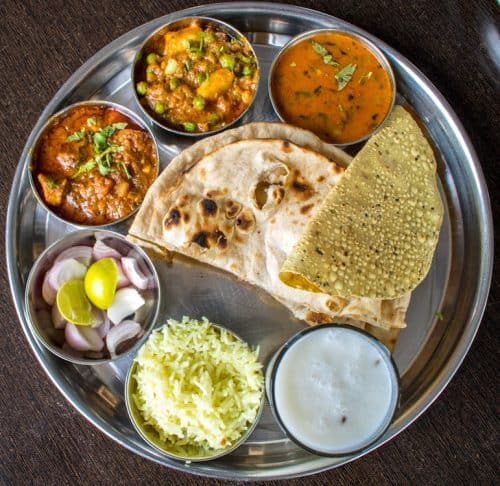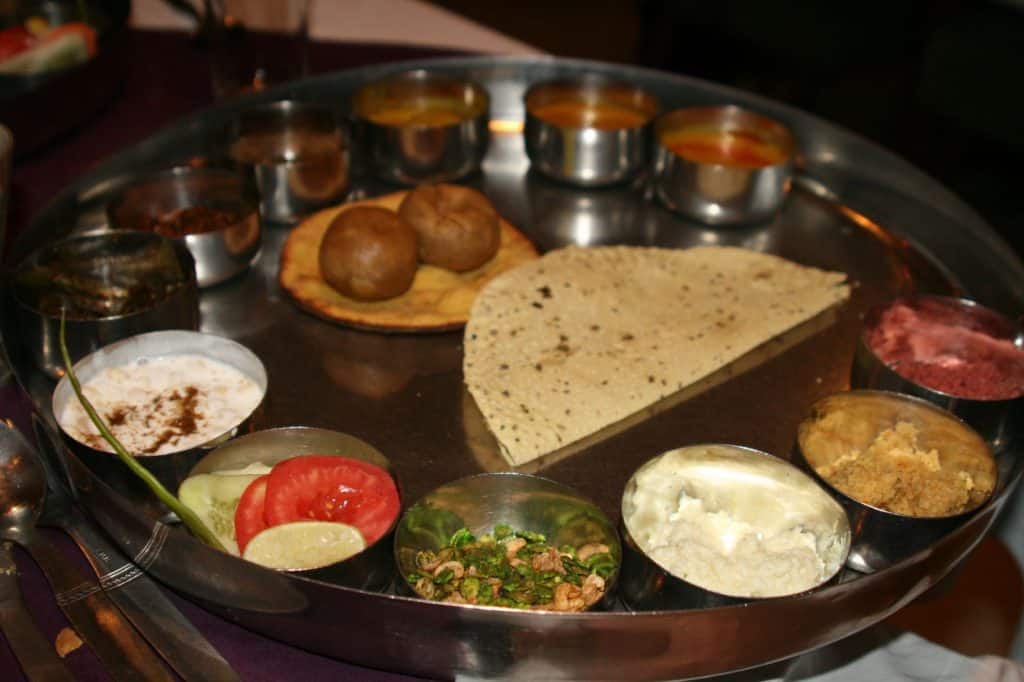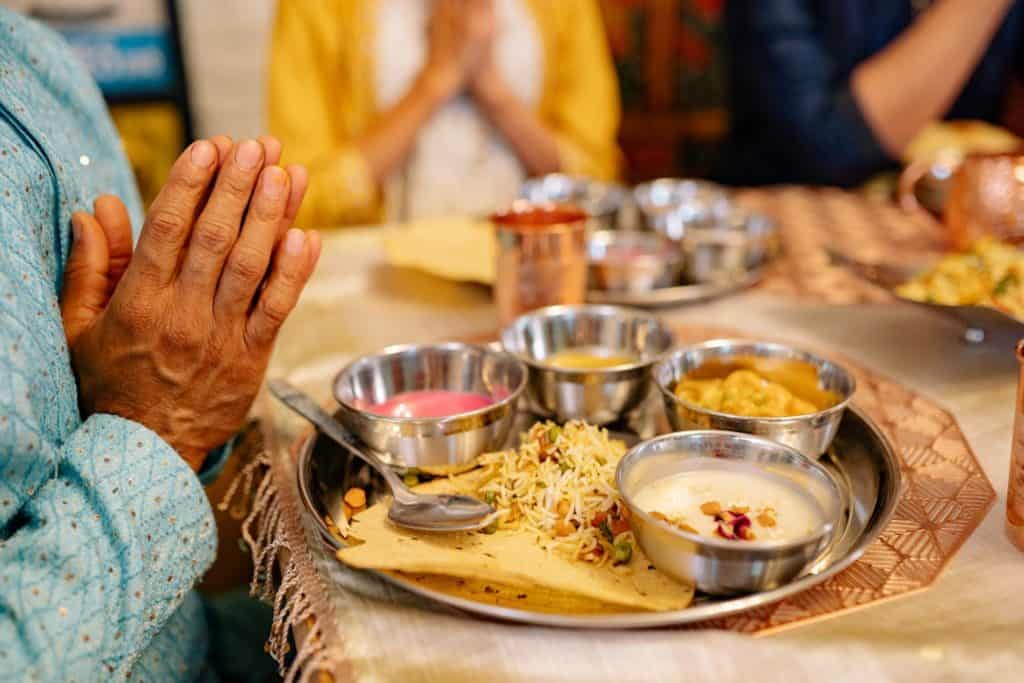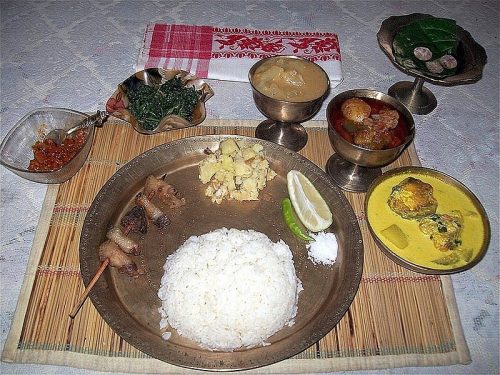Welcome to the world of iconic Indian thalis, where each generous platter is a delicious chapter in the story of regional traditions and tastes. From the tangy treats of Gujarat to the rich curries of Bengal, these thalis are your culinary tour guides.

An Indian thali is a traditional platter widely popular across the country, comprising a variety of dishes served in small bowls, or katoris, placed on a large plate. A typical Indian thali includes rice, bread, vegetables, lentils, pickles, chutneys, and sweets. However, the assortment of dishes can vary depending on the region and the occasion.
In a traditional Indian thali, there are no courses; all the food is served together on one platter. This method has become the most popular way to serve meals in India.
What makes a thali so special is its assortment of dishes, meticulously curated to offer a balance of flavours, textures, and nutrients. Each region in India boasts its own unique thali, reflecting local ingredients, traditional cooking methods, and cultural influences.
From the hearty, spice-laden curries of a Rajasthani thali to the coconut-infused delicacies of a South Indian thali, every platter tells a story of its land.
The thali’s distinctiveness lies in its ability to provide a complete, satisfying meal that delights the palate and nourishes the soul. It’s a celebration of India’s food culture, where variety and harmony come together on a single plate, making it an integral part of festive occasions, daily dining, and the country’s gastronomic legacy.
Moreover, what makes Indian cuisine truly unique is its dining etiquette and serving style. For instance, sitting on the floor and eating is a common practice, and eating with your hands is a cherished part of Indian culture. Most Indians prefer using their fingers over cutlery. You’ll find people enjoying meals in a thali across every corner of India.
What is a Thali?
Thali, a Hindi term for a large plate, is the epitome of a balanced meal in Indian cuisine. Picture a stainless steel platter adorned with 4 to 6 small katoris or bowls, each brimming with a distinct dish. The thali’s purpose is to offer a harmonious blend of six flavours: sweet, salty, bitter, sour, astringent, and spicy, all on one plate.
Every serving is meticulously portioned to ensure a nutritional balance. Thalis are not just for daily meals but also hold a special place in festivals and celebrations, like weddings, making them an integral part of Indian culture.
Determining the best thali is a matter of personal taste and regional pride, but here we present our list of the most famous thalis:
Rajasthani Thali

Rajasthan, the land of heritage and Maharajas, offers a thali as interesting as its culture. Originating from the desert state, the Rajasthani thali is renowned for its hearty, filling dishes. Lavishly draped in ghee (clarified butter), the traditional Rajasthani thali is as rich, colourful, and regal as its cultural heritage.
A typical Rajasthani thali includes dal baati churma (round-shaped bread with various lentils), gatte ki sabzi (gram flour balls in curd gravy and spices), rotis of bajra, jowar, makka, or missi roti (breads of pearl millet, corn, or whole-wheat flatbread), panchmela dal (a mix of five different lentils), Rajasthani Kadhi with its thinner consistency and extra spiciness, ker sangri (a desert bean pickle), boondi chaas (flavoured buttermilk), pulao (steamed rice), and papad. . For dessert, there’s goond ka ladoo (edible gum sweet), moong dal halwa, or imarti (a circular, flower-shaped dessert). It’s truly a gastronomic delight!
For non-vegetarian thalis, the signature dish is Laal Maas, which is an essential part of every Rajasthani thali. Translated as ‘red meat,’ Laal Maas is lamb cooked in a fiery gravy of chillies, onions, yoghurt, and garlic. Another standout is Safed Maas, featuring lamb in a rich gravy of almond-cashew paste, milk, cream, and spices. Sometimes a non-vegetarian thali offers Junglee Maas, a traditional dish made from wild game meat and readily available spices, adding a rustic touch to the thali.
Gujarati Thali
Gujarati cuisine stands out as one of the most unique and diverse in India. Influenced by a myriad of cultures, it boasts a rich and complex culinary tradition. Predominantly vegetarian due to the region’s large Hindu population, Gujarati food is a true feast for the senses.
A distinguishing feature of Gujarati cuisine is its extensive use of lentils. These staple ingredients are often cooked with a variety of spices, resulting in flavorful dishes that are both healthy and satisfying. From mild dishes to spicy delights, traditional Gujarati cuisine will tempt you to break your diet resolutions. The desserts are simply irresistible.

A typical Gujarati thali is a flavorful mix of spicy and slightly sweet dishes. It includes sev tamatar nu shaak (a sweet-spicy tomato gravy), tindora nu shaak (a sweet-and-savoury ivy gourd dish), kathiawadi dhokali nu shaak (wheat flour dumplings in spicy gravy), bharela ringan (stuffed eggplant), rotli (flatbread), bakhri (bread made from pearl millet), tikhari (a spicy, tangy curry), and vaghareli khichdi (a mixture of rice, lentils, and spices).
Essential components of a Kathiawadi thali are buttermilk and kesar shrikhand (saffron-flavoured sweet yoghurt). During mango season, the thali also features aamras (mango pulp). The Gujarati culinary scene finds pride of place in the Indian Thalis countdown.
Karnataka Thali
Karnataka, a coastal state in Southwest India, is both largely agricultural and one of the most economically advanced states in the country. In Karnataka, a traditional thali is called Kannadiga Oota and is distinct amidst the south Indian thalis. This meal is a blend of flavours from neighbouring communities and regions, served on a banana leaf and makes for a must-try amidst the Indian Thalis repertoire.
It typically includes kosambari (South Indian salad), pickle, palya (vegetable side dish), raita or gojju (vegetables cooked in tamarind juice), payasam (sweet dish made of rice and lentils), jolada roti (sorghum flatbread), mirchi bhajji (chilli fritters), akki roti (rice flatbread), thovve (cooked dal), huli (a thick broth of lentils and vegetables), ranjaka (chilli-garlic chutney), padavalkayi masala (snake gourd curry), chitranna (rice-based dish), plain rice, and ghee.
Bengali Thali
Bengal, with its highly fertile soil, has traditionally been an agrarian society, favouring multi-cropping. Cattle are the primary source of dairy products, while vegetables, crops, seeds, and fruits are grown abundantly throughout the year. Bengal cuisine is a integral to any culinary journey featuring Indian Thalis.
The Bengali thali is synonymous with fish and rice, though mutton and goat meat are also popular choices. This thali features non-vegetarian delicacies with subtle yet fiery flavours that leave you craving more.
Specialties include shukto (a sweet-spicy soupy mixture of vegetables), patol bhaja (fried pointed gourd), shak (leafy vegetables), chholar dal (lentil curry), alu bhaate (potatoes mashed with rice), begun bhaja (pan-fried eggplant), machher jhol (traditional fish curry), maach bhaja (fish fry), mutton curry, chadachadi (char-flavored vegetable dish), and sweet-tangy chutneys (mango, papaya, tamarind, etc.). This scrumptious meal is finished with mishti doi (sweet yogurt) and payesh (rice and milk pudding).
Maharashtrian Thali
A Maharashtrian Thali consists of traditional dishes from the state of Maharashtra. A typical vegetarian menu includes koshimbir (salad), aamti or varan (lentil curries), rotis made with various flours, vegetables, lentils, pickles, other condiments, drinks, and sweets.
The Maharashtrian Thali offers a delicious mix of vegetarian and non-vegetarian options, allowing you to choose your preferred dishes. Rich in flavor and spices, a traditional Maharashtrian thali typically features kothimbir vadi (coriander fritters), bhakri roti (millet flatbread), pitla (chickpea flour curry), bhajis such as vangyache bharit (eggplant-based dish), batatyachi bhaji (dry potato sabzi), or matkichi bhaji (sprouted moth beans curry). It also includes amti (tangy curry made from yellow lentils), mutton kolhapuri (spicy mutton curry), andhra rassa (chicken in white gravy), kosimbir (salad), puran poli (sweet flatbread), and a refreshing glass of yogurt-based drink (mattha).
Punjabi Thali
Punjabi cuisine originates from the Punjab region in northern South Asia, now divided between India and Pakistan. This cuisine boasts a rich tradition of distinct local cooking methods. Punjabi thalis are known for their hearty dishes, often featuring ghee, paneer, and a variety of lentils, along with a wide assortment of breads.
Punjabis are true food enthusiasts, and the Punjabi thali is a testament to their love for food! Known as the ‘Bread Basket of India,’ Punjabi cuisine is lively and bursting with flavours.
Signature dishes include pindi chole (spicy chickpea curry), Amritsari aloo kulcha (stuffed flatbread), dal makhani (black lentils and red kidney beans), pakoda kadhi (fritters in yogurt gravy), jeera rice (rice with cumin seeds), pickles of cauliflower, carrot, and turnip, and sweet lassi (yogurt or buttermilk drink). Other highlights are sarson ka saag (mustard greens) and rajma chawal (red kidney beans in thick gravy).
The non-vegetarian platter features butter chicken and succulent Amritsari fish. This wholesome meal is sure to provide a delightful culinary experience!
Assamese Thali
Every state in India has its unique Thali culture, and Assam is no exception. In the northeastern state of Assam, the thali offers a delightful way to explore the local culture through its cuisine. Assam is home to many tribes, each with its own languages, traditions, and culinary customs, all contributing to the richness of the Assamese thali. From staple rice to flavorful fish curries, the Assamese thali celebrates locally sourced ingredients and traditional cooking techniques.
There are no strict rules for eating a thali, but following some cultural guidelines can enhance your dining experience. Here are a few details to help you better understand an Assamese thali.
Assamese cuisine is known for its slow cooking, strong flavours, and sparing use of spices. The abundance of endemic plants, vegetables, and animal products is a hallmark of their daily cooking. An Assamese thali typically includes khar (a curry made with raw papaya, dried banana skins, and lentils), masor tenga (a light fish dish), narasingh masor jhol (an authentic fish curry), poitabhat (a rice-based dish), pitika (a side dish of mashed vegetables), pickles, and bor (fritters). For dessert, the meal is completed with pitha (rice cake).

Goan Thali
Goan cuisine, celebrated for its blend of flavours and coastal influences, offers a diverse and delicious array of dishes. The Goan Thali, a traditional meal that embodies the essence of this coastal Indian state, provides a simple yet soul-satisfying culinary experience.
Seafood, fish, and rice are staples in Goa. While there are thalis for both vegetarians and meat-eaters, the non-vegetarian thali is more popular and widely available. A typical Goan thali includes sheet kodi nustea (fish curry rice), kismur (dry prawn salad with grated coconut), cabbage foogath (steamed cabbage), prawn caldin curry, pork or vegetable vindaloo, kele ambat (plantain gravy), poee (Goan bread), and Goan banana halwa (dessert). Finish your meal with sol kadi (a kokum-coconut-based drink).
This list doesn’t just end here, many more Indian thalis are worth trying. Each state brings its unique flavours and traditions to the table, creating a mosaic of tastes that reflect the cultural heritage and local ingredients of the region.
Whether it’s the robust and hearty dishes of Punjab, the subtle and fiery flavours of Bengal, the wholesome and flavorful offerings of Maharashtra, or the coastal delights of Goa and Assam, each thali is a feast for the senses. These traditional meals not only satiate the palate but also provide a deeper understanding of India’s culinary diversity.
Read more: Latest



